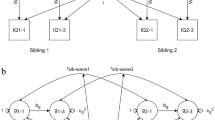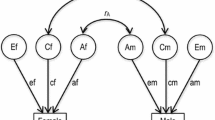Abstract
To test the hypothesis that the etiology of covariation among measures of cognitive ability and academic achievement is due at least in part to shared genetic influences, data from 198 adoptive and 220 nonadoptive families participating in the Colorado Adoption Project were subjected to multivariate behavioral genetic analyses. Data on measures of cognitive ability (verbal comprehension and perceptual organization) and academic achievement (reading recognition and mathematics achievement) from related and unrelated sibling pairs tested at age 7, as well as from adoptive and nonadoptive parents, were analyzed. Phenotypic analyses confirmed previous findings of moderate correlations among measures of cognitive ability and achievement, averaging about .35. Although 54% of the covariation between reading and mathematics achievement was due to influences shared with verbal ability, a significant proportion of this covariation was independent of the cognitive ability measures. Heritabilities for the various measures were moderate, ranging from .21 to .37. Moreover, genetic influences accounted for 33–64% of their phenotypic covariation; for example, 33–60% of the observed correlations between verbal comprehension and the achievement measures, 64% of those between perceptual organization and the achievement measures, and 63% of that between reading recognition and mathematics achievement were due to shared genetic influences. Similar to the results of the phenotypic analysis, nearly half of the genetic covariance between reading and mathematics achievement was independent of cognitive ability. Their remaining covariance was due primarily to nonshared environmental influences.
Similar content being viewed by others
References
Brooks, A., Fulker, D. W., and DeFries, J. C. (1990) Reading performance and general cognitive ability: A multivariate genetic analysis of twin data.Personal. Indiv. Diff. 11: 141–146.
Cardon, L. R., DiLalla, L. F., Plomin, R., DeFries, J. C., and Fulker, D. W. (1990). Genetic correlations between reading performance and IQ in the Colorado Adoption Project.Intelligence 14:245–257.
Carey, G. (1986). A general multivariate approach to linear modeling in human genetics.Am. J. Hum. Genet. 39:775–786.
Cherny, S. S., and Cardon, L. R. (1994). General cognitive ability. In J. C. DeFries, R Plomin, and D. W. Fulker (eds.),Nature and Nurture During Middle Childhood, Blackwell, Oxford.
Cloninger, C. R. (1980). Interpretation of intrinsic and extrinsic structural equation relations by path analysis: Theory and application to assortative mating.Genet. Res. 36: 133–145.
Connolly, A. J., Nachtman, W., and Pritchett, E. M. (1976).KeyMath Diagnostic Arthmetic Test, American Guidance Service, Cricle Pines, MN.
DeFries, J. C., Plomin, R., and LaBuda, M. C. (1987). Genetic stability of cognitive development from childhood to adulthood.Dev. Psychol. 23:4–12.
DeFries, J. C., Plomin, R., and Fulker, D. W. (1994).Nature and Nurture During Middle Childhood, Blackwell, Oxford.
Dunn, L. M., and Markwardt, F. C. (1970).Examiner's Manual: Peabody Individual Achievement Test, American Guidance Service, Circle Pines, MN.
Eaves, R. C., and Darch, C. (1990). The cognitive levels test: It's relationship with reading and mathematics achievement.Psychol Schools 27:22–28.
Gillis, J. J. (1993).Comorbidity of Reading and Mathematics Disabilities: Genetic and Environmental Etiologies. Unpublished doctoral dissertation, University of Colorado, Boulder.
Jensen, A. R. (1972).Genetics and Education, Harper and Row, New York.
Kaufman, A. S. (1975). Factor analysis of the WISC-R at 11 age levels between 61/2 and 161/2 years.J. Consult. Clin. Psychol. 43:135–147.
Loehlin, J. C., and Nichols, R. C. (1976).Heredity Environment, and Personality: A Study of 850 Sets of Twins, University of Texas Press, Austin.
McCall, R. B., Evahn, C., and Kratzer, L. (1992).High School Underachevers: What Do They Achieve as Adults? Sage, Newbury Park, CA.
McGue, M., Bouchard, T. J., Iacono, W. G., and Lykken, D. T. (1993). Behavioral genetics of cognitive ability: A life-span perspective. In R. Plomin and G. E. McClearn (eds.),Nature and Nurture, American Psychological Association, Washington, D.C.
Neale, M. C. (1991).Mx: Statistical Modeling. Department of Human Genetics, Box 3 MCV, Richmond, VA 23298.
Neale, M. C., and Cardon, L. R. (1992).Methodology for Genetic Studies of Twins and Families, NATO ASI Series, Kluwer Academic Press, Dordrecht, The Netherlands.
Neale, M. C., Walters, E. E., Eaves, L. J., Maes, H. H., and Kendler, K. S. (1994). Multivariate genetic analysis of twin-family data on fears: An MX model.Behav. Genet. 2:119–139.
Oakland, T., and Stern, W. (1989). Variables associated with reading and math achievement among a heterogeneous group of students.J. School Psychol. 27:127–140.
Pennington, B. F., Gilger, J. W., Olson, R. K., and DeFries, J. C. (1992) The extermal validity of age- versus IQ-discrepancy definitions of reading disability: Lessons from a twin study.J. Learn. Dis. 25:562–573.
Phillips, D. K. (1988).Quantitative Genetic Analysis of Longitudinal Trends in IQ in the Colorado Adoption Project, Unpublished doctoral dissertation, University of Colorado Boulder.
Phillips, K. (1989). Delta path methods for modeling the effects of multiple selective associations in adoption designs.Behav. Genet. 3:609–620.
Phillips, K., and Fulker, D. W. (1989). Quantitative genetic analysis of longitudinal trends in adoption designs with application to IQ in the Colorado Adoption Project.Behav. Genet. 19:621–658.
Plomin, R., and DeFries, J. C. (1979). Multivariate behavior genetic analysis of twin data on scholastic abilities.Behav. Genet. 9:505–517.
Plomin, R., and DeFries, J. C. (1985).Origins of Individual Differences in Infancy: The Colorado Adoption Project Academic Press, Orlando, FL.
Plomin, R., DeFries, J. C., and Fulker, D. W. (1988)Nature and Nurture in Infancy and Early Childhood: Cambridge University Press, Cambridge.
Rutter, M., and Yule, W. (1975). The concept of specific reading retardation.J. Child Psychol. Psychiat. 16:181–197.
Shepard, L. (1980). An evaluation of the regression discrepancy method for identifying children with learning disabilitiesJ. Spec. Educ. 14:79–91.
Siegel, L. S. (1989). IQ is irrelevant to the definition of learning disabilities.J. Learn. Disabil. 22:469–478.
Thompson, L. A., Detterman, D. K., and Plomin, R. (1991). Association between cognitive abilities and scholastic achievement: Genetic overlap, but environmental differences.Psychol. Sci. 2: 158–165.
Van Eerdewegh, P. (1982).Statistical Selection in Multivariate Systems with Applications in Quantitative Genetics, Unpublished doctoral dissertation, Washington University, St. Louis, MO.
Wadsworth, S. J. (1994). School achievement. In J. C. DeFries, R. Plomin, and D. W. Fulker (eds.),Nature and Nuture During Middle Childhood, Blackwell, Oxford.
Wadsworth, S. J., DeFries, J. C., Fulker, D. W., and Plomin, R. (1995). Covariation among measures of cognitive ability and academic achievement in the Colorado Adoption Project: Sibling analysis.Personal. Indiv. Diff. (in press).
Wechsler, D. (1974).Examiner's Manual: Wechsler Intelligence Scale for Children—Revised. The Psychological Corporation, New York.
Wechsler, D. (1981).Examiner's Manual: Wechsler Adult Intelligence Scale—Revised, The Psychological Corporation, New York.
Wong, B. Y. L. (1989). Is IQ necessary in the definition of learning disabilities? Introduction to the special series.J. Learn. Disabil. 22:468.
Wright, S. (1968)Evolution and Genetics of Populations, Vol. 1, University of Chicago Press, Chicago.
Author information
Authors and Affiliations
Rights and permissions
About this article
Cite this article
Wadsworth, S.J., DeFries, J.C., Fulker, D.W. et al. Cognitive ability and academic achievement in the Colorado Adoption Project: A multivariate genetic analysis of parent-offspring and sibling data. Behav Genet 25, 1–15 (1995). https://doi.org/10.1007/BF02197237
Received:
Accepted:
Issue Date:
DOI: https://doi.org/10.1007/BF02197237




